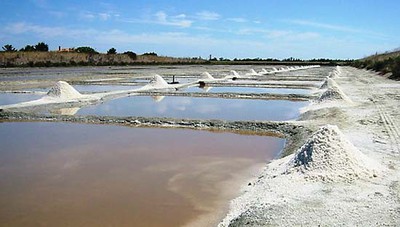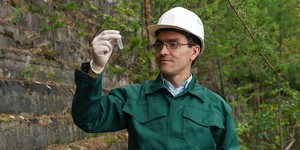Abstract
Have you ever been swimming at the beach and gotten some water in your mouth by mistake? Then you know that the ocean is very salty. But what about other bodies of water? How much salt do they have compared to the ocean?Summary
Sara Agee, Ph.D., Science Buddies

Objective
In this experiment you will test several freshwater and saltwater samples to see how much salt they contain.
Introduction
People often wonder how salty the ocean is, but what does this mean? What you are really asking is how much salt is dissolved in the water, called salinity. When something is dissolved in water it often seems to disappear. But even though the water may look clear the dissolved substance is still there. When something can dissolve in water we say that it is soluble. Salt happens to be very soluble in water compared to other substances, like sugar for example.
Different bodies of water contain different amounts of dissolved salts and have different salinities. The two main types of aquatic environments are freshwater habitats (lake, river, pond, stream) and salt water habitats (ocean, gulf, sea, bay). Another type of aquatic environment is called an estuary, which forms where a fresh body of water mixes together with a salty body of water. Estuaries are commonly found at the mouths of rivers and deltas, and act as a kind of nursery for the ocean.

How is salinity measured? The amount of salt dissolved in the water is often measured in parts per thousand (ppt) which is very similar to the grams of salt per liter of solution (g/L). That means if you have a 1 ppt salt solution, then if you filled up a 1 liter water bottle, it would have about 1 gram of salt inside. Seawater is usually somewhere between 33 and 37 ppt, which means that a 1 liter bottle of seawater would have 33–37 grams of salt inside!
In this experiment you will learn a simple way to measure the amount of salt in a sample of water by using evaporation. After the water of a solution evaporates, the dissolved salts are left behind. By collecting water samples from different bodies of water and evaporating them, you can find out how much salt there is in an ocean, lake, bay, or stream near your city.
Terms and Concepts
- Salt water habitats
- Oceans
- Seas
- Gulfs
- Bays
- Estuaries
- Fresh water habitats
- Lakes
- Streams
- Ponds
- Rivers
- Salinity
- Parts per thousand (ppt)
Questions
- What is the difference in salinity between salt water and fresh water aquatic environments?
- How salty are estuaries?
- How can salinity be measured?
Bibliography
- National Earth Science Teachers Association. (2001, August 30). Salinity - Dissolved Salts, Measuring Salinity. Retrieved February 26, 2016.
- National Earth Science Teachers Association. (2001, August 30). Salinity. Retrieved February 26, 2016.
- Here you can read all about salt, what it is made of, where we get it and what we use it for:
Salt Institute. (n.d.). The Salt Institute Home Page. Retrieved February 26, 2016.
Materials and Equipment
- Glass canning jars, 16 oz (3 per location you want to test), available from Amazon.com
- Cookie sheet
- Oven
- Liquid measuring cup, metric
- Metric scale (range up to 3000g and 0.1g precision); available from Amazon
- Sharpie or other permanent marker
- Distilled water, found in the bottled water section of most grocery stores
Disclaimer: Science Buddies participates in affiliate programs with Home Science Tools, Amazon.com, Carolina Biological, and Jameco Electronics. Proceeds from the affiliate programs help support Science Buddies, a 501(c)(3) public charity, and keep our resources free for everyone. Our top priority is student learning. If you have any comments (positive or negative) related to purchases you've made for science projects from recommendations on our site, please let us know. Write to us at scibuddy@sciencebuddies.org.
Experimental Procedure
- You will be collecting several samples from different locations and making measurements during this experiment. You will want to make a data table to write down and organize your data:
| Location | Freshwater or Saltwater? | Weight of Jar Before (g) | Weight of Jar After (g) | Weight of Jar (g) | Volume of Water (L) | Amount of Salt (g) | Salinity (g/L) |
|---|---|---|---|---|---|---|---|
| negative control | distilled | ||||||
| Berkeley Marina | salty | ||||||
| Walden Pond | fresh | ||||||
| Cedar Creek | fresh | ||||||
| Ocean Beach | salty | ||||||
| etc... |
- Weigh each empty jar, without the lid, and write the weight in grams directly on the jar with a permanent marker.
- Collect samples of water from several sites that you think will have different salinities. Choose some freshwater sites (lakes, rivers, streams, springs, etc.) and some marine sites (beaches, marinas, bays, estuaries, etc.) for your study. Write the locations in your data table.
- Collect each sample by filling a canning jar with the water at the site and securing the lid. Then write the date, time, and place that you collected your sample on the jar with a permanent marker. Collect three samples for each location. Why? So that you know that the data you get from each location is really representative of that place rather than a one-time fluke.
- After you collect your samples, each jar should be full to the brim with water and sealed tightly. If they are not full, you will need to remove some water from a few of the jars until the water level for all of the jars is the same.
- If any of the water samples have lots of particles floating or collecting at the bottom of the jar, you will need to find a way to filter the particles out of the water. One idea is to use an old T-shirt as a simple filter.
- Take a new, empty jar and weigh the jar with your metric scale in grams. Write the weight in grams in your data table.
- In the new empty jar, fill the jar with distilled water to the same level as the other jars. Then measure the amount of water in liters (L) by pouring it into a large, metric liquid measuring bowl. Write this measurement down in your data table. It will be the total volume of liquid you collected from each site. Then re-fill the jar and use it as your negative control.
- Next you will need to evaporate the water in the jars. There are several ways to do this:
- Arrange all of your jars on a cookie sheet and carefully place them in a sunny location. Carefully remove the lids and leave them there for several weeks to evaporate.
- Or, bake all of the jars in the oven at a very low temperature (200°F) until the water has evaporated. This will take roughly 24-36 hours depending on your oven and the volume of water. A convection oven would be faster.
- You may also do any combination of the above methods (sunny location or oven) as long as you treat all the jars the same.
- After the jars have dried completely, weigh each jar in grams, and write the weight in grams in the data table.
- Subtract the weight of the empty jar (step 5) from the final weight of each jar you filled with a water sample. This is the amount of salt that was present in that water sample.
- Now divide the amount of salt in grams by the amount of water in liters, and this will give you the salinity, or concentration of salt, of the sample measured in grams per liter (g/L).
- Make a bar graph of your data to compare the salinity of each water sample. Make a scale on the left side of the graph (y-axis) representing the different ranges of salinity from your study. Then draw a bar for each sample up to the corresponding salinity level. Which samples had the most salt? Which had the least?
Ask an Expert
Global Connections
The United Nations Sustainable Development Goals (UNSDGs) are a blueprint to achieve a better and more sustainable future for all.
Variations
- If you have access to one, you can also use a refractometer to measure salinity. As the amount of salt in the water increases, so does the index of refraction. Try repeating the experiment taking measurements with a refractometer. Do you get similar results? Which method is more accurate? For a more advanced project idea on the index of refraction, see the Science Buddies experiment Measuring Sugar Content of a Liquid with a Laser Pointer.
- Many organisms that live in saltwater environments cannot live in a freshwater environment, and vice versa. Why do you think that is? Do an experiment using a very simple salt water organism, the Brine Shrimp, to see what effect changes in salinity can have. You can buy a Brine Shrimp hatchery at your local pet store to hatch and rear the brine shrimp. Then you can expose the brine shrimp to water samples of different salinities. What will happen?
Careers
If you like this project, you might enjoy exploring these related careers:









